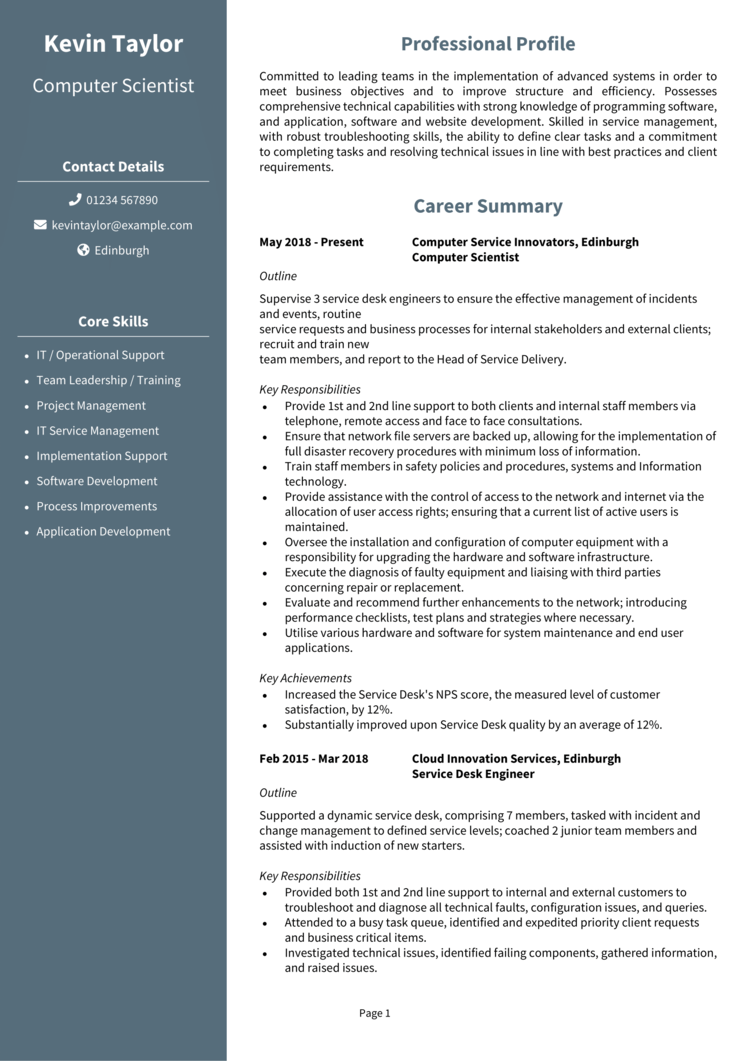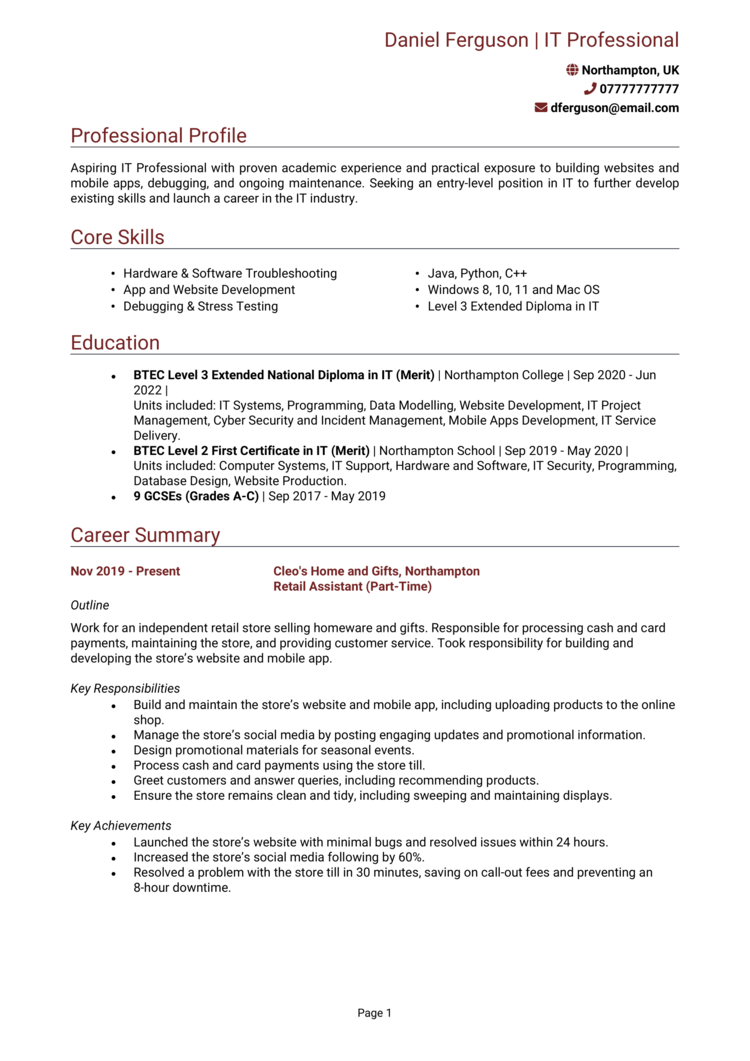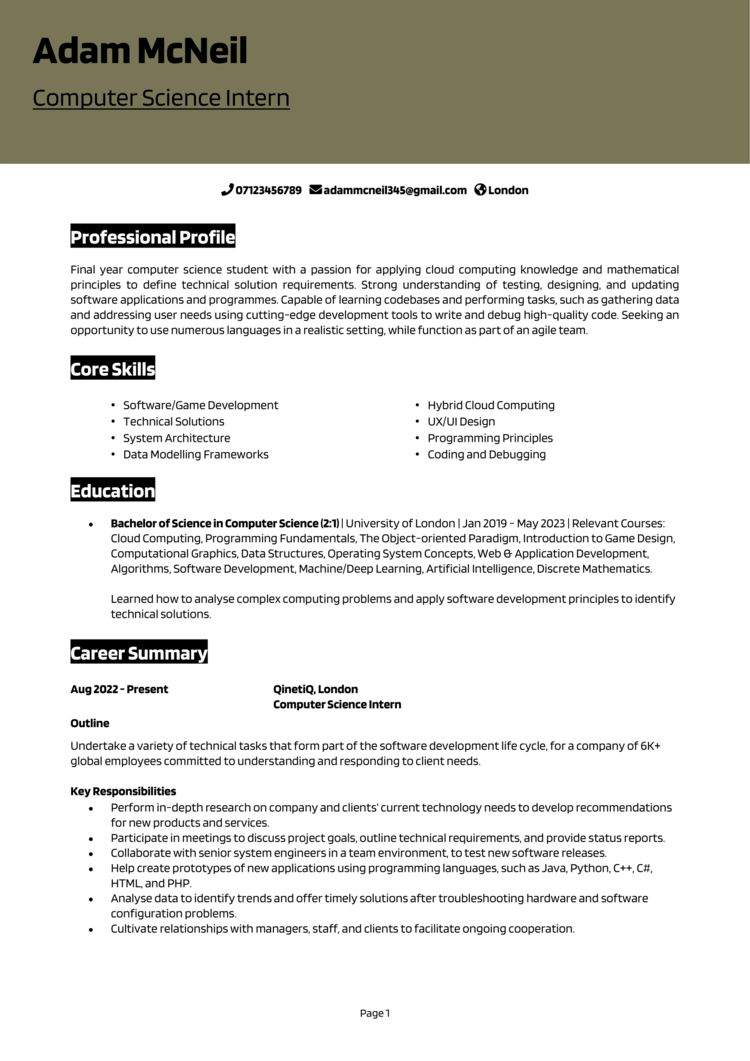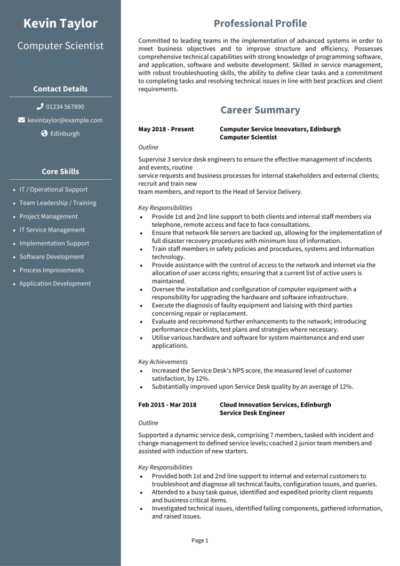Are you ready to compile the perfect CV and execute your dream job search?
Whether you’re a seasoned programmer or a recent graduate eager to kickstart your career, a strong CV is essential. Just like a well-written program, your CV needs to be structured and efficient, and tailored to its user – recruiters.
This guide, complete with 3 Computer Science CV examples, will show you how to craft a CV that showcases your computing expertise and ability to bring innovative ideas to life, and sets you apart in this high-demand sector.
Computer Scientist CV example

Computer Science (no exp) CV

Computer Science Internship CV

How to write your Computer Science CV
Learn how to create your own interview-winning Computer Science CV with this simple step-by-step guide.
A Computer Science CV is a snapshot of your technical skills, past projects, and problem-solving abilities that demonstrate the value you intend to bring to a team or organisation.
This guide will help you write a CV that highlights your education and practical experience, setting you up for success in any computer science-related role.
The best way to structure your Computer Science CV


Your CV should be as clean and logical as your best codebase – no debugging required. Recruiters need to see your qualifications, skills, and achievements at a glance, without having to navigate through spaghetti code to find it.
Here’s how to structure your Computer Science CV:
- Name and contact details – Display your personal details clearly at the top so employers can get in touch easily. Adding a photo is optional.
- Profile – Begin with a concise summary that highlights your expertise and what you bring to the role.
- Core skills – Briefly highlight those qualities which make you the best candidate, like your expertise in programming, databases, and software development.
- Work experience – List your previous roles in reverse chronological order, with your most recent first.
- Education – Mention the academic history which underpins your expertise, from degrees to computing certifications.
- Additional info – You can also note hobbies and interests that reflect your technical creativity or problem-solving mindset.
Computer Science CV format


A poorly formatted CV is like buggy code – it’s going to frustrate the user (in this case, the recruiter). A clean, professional layout avoids mistakes and ensures your CV is easy to read and makes an impact.
Here’s how to format your Computer Science CV:
- Bullet points – These help recruiters skim through your accomplishments quickly and easily.
- Divide sections – Break your CV into distinct sections with clear headings for smooth navigation.
- Use a clean font – Use a simple, professional font and keep your layout uncluttered for maximum readability.
- Keep it the right length – No more than 2 pages, which is enough space to highlight your expertise while keeping the recruiter interested.
Creating a strong Computer Science CV profile


Your CV profile needs to grab the recruiter’s attention and convince them of the benefits you’d bring to their company. Use this section to highlight your technical skills, projects, and career aspirations.
Computer Science CV profile examples
Profile 1
Motivated Computer Science graduate with a strong foundation in programming, algorithms, and data structures. Skilled in Python, Java, and SQL, with experience in developing web applications and working on academic projects. Seeking to apply technical expertise in a dynamic environment.
Profile 2
Organised Software Developer with three years of experience in computer science applications, specialising in back-end development and database management. Skilled in C++, MongoDB, and AWS. Proficient in optimising system performance and creating scalable solutions for enterprise systems.
Profile 3
Experienced Computer Scientist with over five years of expertise in data analysis, machine learning, and artificial intelligence. Skilled in TensorFlow, R, and Python, with a focus on developing predictive models and automating complex workflows. Known for delivering innovative solutions to technical challenges.
What to include in your Computer Science CV profile
Here are some tips on what to include in your Computer Science CV profile:
- Where you’ve worked – Specify the sorts of companies, industries, or roles where you’ve applied your skills.
- Your top qualifications – Include degrees or certifications in computer science, software engineering, or related fields.
- Key skills – Make sure to mention your expertise like programming, algorithm design, or systems architecture.
- Programming languages – Different computing roles will require different coding language knowledge, so make sure you state which ones you’re most proficient in.
- Projects you’ve worked on – Reference personal, academic, or professional projects that demonstrate your abilities.
- Tools you’ve used – Mention proficiency with specific tools, frameworks, or platforms relevant to the role.
Core skills section


Your core skills section is like the library of your CV – it showcases the tools and abilities you bring to the table.
For computer science roles, focus on technical skills like programming languages, system design, and data analysis. Tailor this section to match the job description for the role you’re applying for.
Top skills for your Computer Science CV
- Programming Languages – Proficiency in languages like Python, Java, C++, or JavaScript to develop efficient and scalable software.
- Data Structures and Algorithms – Designing and implementing optimised solutions using advanced data structures and algorithmic techniques.
- Database Management – Working with relational databases (e.g., MySQL, PostgreSQL) and NoSQL systems (e.g., MongoDB) to store and manage data.
- Machine Learning – Building predictive models and algorithms using frameworks like TensorFlow, PyTorch, or scikit-learn.
- Software Development Life Cycle (SDLC) – Following methodologies like Agile or Waterfall to plan, develop, test, and deploy applications.
- Cloud Computing – Implementing cloud solutions using platforms like AWS, Microsoft Azure, or Google Cloud for scalability and performance.
- Cybersecurity – Identifying vulnerabilities, implementing security protocols, and ensuring data protection against cyber threats.
- Web Development – Creating responsive and interactive websites using HTML, CSS, JavaScript, and modern frameworks like React or Angular.
- Operating Systems – Understanding the architecture and functionality of systems like Linux, Windows, and macOS for software integration.
- Version Control Systems – Using tools like Git and platforms like GitHub or GitLab for collaboration and code management.
Work experience


Your work experience section is where you show that you’ve gone beyond ‘Hello, World!’ and delivered real-world results in practical settings. Highlight your contributions to projects, responsibilities, and the results you achieved.
If you’re just starting out, don’t worry – university projects and hackathons make for great debugging stories to impress recruiters.
How should you list jobs on your Computer Science CV?

- Outline – Provide an overview of the company, your role, and the projects or systems you worked on.
- Responsibilities – Highlight tasks like coding, debugging, or collaborating with teams. Use action verbs like “developed,” “designed,” or “implemented.”
- Achievements – Showcase measurable results, such as reducing system downtime, optimising performance, or completing projects ahead of schedule. Always list roles in reverse chronological order, starting with the most recent.
Example jobs for Computer Science
Software Engineer | Digital Nexus Ltd
Outline
Designed and developed web-based applications, focusing on performance, scalability, and user experience. Collaborated with cross-functional teams to ensure high-quality deliverables.
Responsibilities
- Developed back-end systems using Python and Flask, integrating APIs for seamless functionality.
- Optimised SQL queries to improve database performance and reduce latency.
- Created dynamic front-end components using JavaScript and React.
- Performed system testing to identify and resolve bugs before deployment.
- Documented project workflows and provided training to junior developers.
Achievements
- Reduced page load times by 25 percent through back-end optimisation.
- Delivered a key feature that increased user retention by 15 percent.
- Recognised for implementing a robust data handling system that improved reliability.
Research Assistant | AI Labs
Outline
Supported academic research in artificial intelligence, focusing on natural language processing and machine learning algorithms. Developed tools and datasets to assist in advanced computational research.
Responsibilities
- Built machine learning models using TensorFlow to analyse and classify text data.
- Conducted experiments to evaluate model accuracy and optimised performance.
- Prepared and cleaned datasets for use in supervised and unsupervised learning.
- Authored technical documentation and contributed to published research papers.
- Collaborated with professors and students to present findings at academic conferences.
Achievements
- Increased model accuracy by 10 percent through feature engineering and tuning.
- Published two co-authored papers in respected computer science journals.
- Developed an open-source tool that has been adopted by the wider research community.
IT Intern | DataSecure
Outline
Completed a summer internship focused on enhancing the security and functionality of enterprise IT systems. Gained hands-on experience in system administration and troubleshooting.
Responsibilities
- Assisted in the configuration and maintenance of company servers and networks.
- Performed vulnerability assessments and implemented basic security measures.
- Troubleshot hardware and software issues for internal teams.
- Developed automation scripts using PowerShell to streamline routine tasks.
- Documented IT workflows and created user guides for common troubleshooting processes.
Achievements
- Improved system uptime by 10 percent through proactive maintenance.
- Streamlined internal processes with automation scripts, reducing manual effort by 20 percent.
- Praised by supervisors for a thorough and detail-oriented approach to tasks.
How to write your education section


The education section is vital for computer science roles, as it demonstrates your foundational knowledge and technical training.
Include degrees, certifications, and any specialised courses in computer science, software development, or related fields. List your qualifications in reverse chronological order, starting with the most recent.
What qualifications do employers look for in Computer Science candidates?
- Bachelor’s Degree in Computer Science – Comprehensive training in algorithms, programming, and system design.
- Master’s Degree in Data Science – Advanced understanding of machine learning, big data, and analytics.
- AWS Certified Solutions Architect – Expertise in designing cloud-based solutions.
- Certified Kubernetes Administrator (CKA) – Skills in container orchestration and management.
- Microsoft Certified: Azure Fundamentals – Proficiency in cloud services and architecture.





